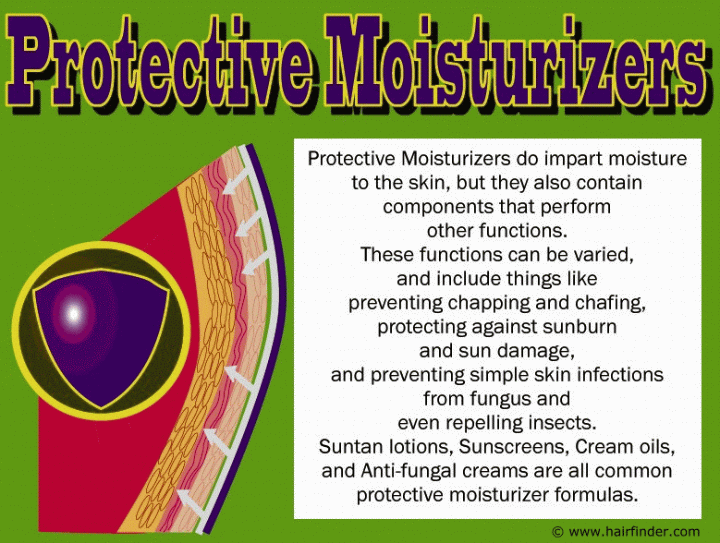Moisturizers (2)
Previous pageProtective Moisturizers:

These moisturizers serve a dual function compared to other types of moisturizers. They do impart moisture to the skin, but they also contain components that perform other functions. These functions can be varied, and include things like preventing chapping and chafing, protecting against sunburn and sun damage, and preventing simple skin infections from fungus and even repelling insects.
Suntan lotions, Sunscreens, Cream oils, and Anti-fungal creams are all common protective moisturizer formulas. The jobs they perform can vary widely, but they generally all are formulated because the situations for which they are created either call for or benefit by adding moisture to the skin as well as the protective element.
It is a fairly common practice to apply a good moisturizer to clean skin before you apply your foundation make-up. This is important because dry skin will pull moisture from wherever it can, which means if you apply a liquid foundation to a face with dry skin areas, you can get results that are very disparate. The areas where the skin is dry can become cakey as the dry skin beneath draws the moisture from the foundation.
Such looks are unpleasant and can create problems as addition cosmetics are applied. Having dry skin prone to absorbing foundation make-up can also lead to skin breakouts and clogged pores.
The addition of moisturizer before foundation helps to saturate dry areas of the skin, and allows the foundation to rest lightly on the surface of the skin. This means that the make-up will blend more smoothly and cover more evenly; keeping that evenness as the foundation wears through the day.
Choosing a Moisturizer
You need to remember that the type of moisturizer you need is dependent on the particulars of your skin. Some skin types respond well to heavier moisturizers, and need protective agents that are available in some formulas. Other types need very light moisturizers that penetrate easily and absorb quickly into the skin. Let's talk basic skin types and the moisturizers that are needed.
Dry Skin
Obviously dry skin needs lots of moisture. Use a gentle facial cleanser and a humectant-rich formula that will help the skin absorb and retain as much moisture as possible. If you plan to spend the day outdoors without make-up, you might wish to use a moisturizer such as a light cream oil moisturizer that not only adds moisture to the dry skin, but grants a protective layer to the skin's surface to protect against irritation from the elements. Such products are especially good for use in dry climates and harsh winter weather.
Oily Skin
With oily skin, the moisture needs still exist, but must be balanced against the abundant sebum produced by the skin naturally. Use a good skin cleanser and astringent to remove excess sebum and tighten the pores, and follow up with a very light, highly-absorptive moisturizer.
Avoid any oil-based moisturizers since these only exacerbate the oily skin problem. Use a foundation designed for oily skin so that you can keep the oil-levels under control after your make-up is applied.
Combination Skin
Most of us don't have just "oily" or "dry" skin. We have areas of the skin that are oilier than others and areas that are drier than others, usually oily in the forehead and nose areas, called the T-zone. For these situations the trick is to use a mid-range moisturizer, to find a balance between the needs of the drier and oilier areas.
Select a cleanser for combination skin, that contains oil-fighting agents and gentle surfactants to balance the two disparities in the skin, then use the moisturizer to provide even moisture coverage.
©Hairfinder.com
See also: Make-up how to